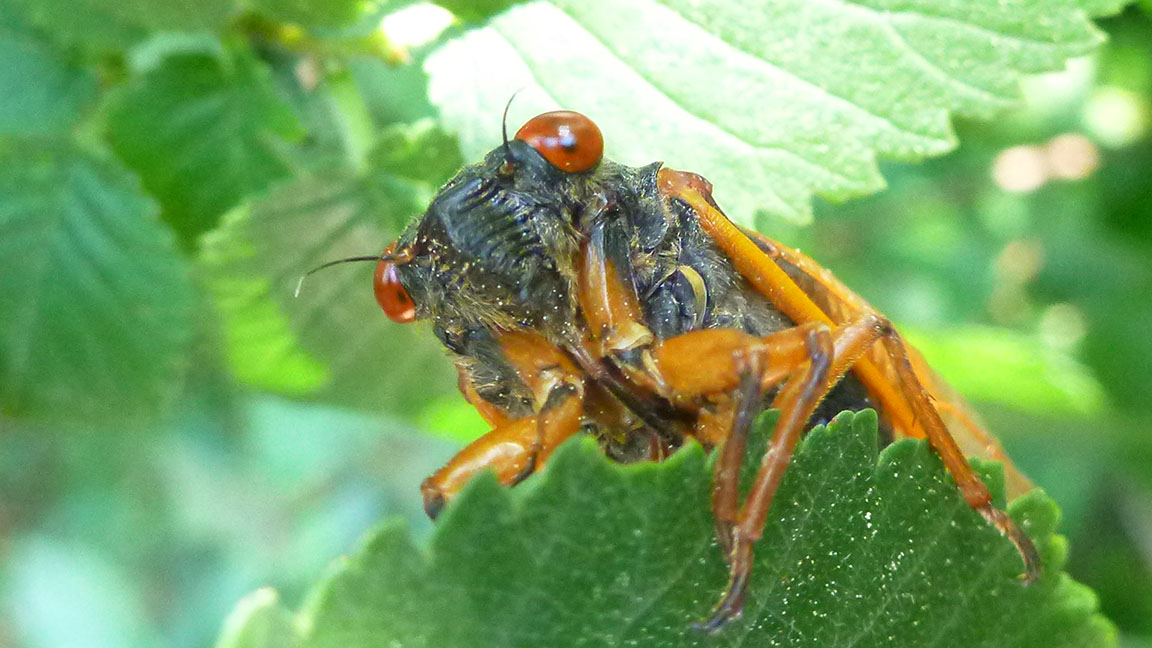
I DIDN’T GO looking for the cicadas, really, but since I was there, I went looking for the cicadas. That is, I was finally all the way vaccinated, and the weekend was clear, or as clear as the weekends get, so I drove down to see my mom for the first time in months, in the house I grew up in. Thirty-four years ago, at the peak of the emergence, there were cicadas climbing up the wooden sides of the house and the fenceposts by the carport. The carport has been gone for years and years now; my parents got it torn down and replaced it with sort of a wide side porch or entry deck, plus a whole detached garage built at the head of the driveway, where the sand pile and the broken-down VW Bug used to be.
So I was on my home soil again, and I’d had the cicadas in mind since last summer at least, but it was early. People were writing or tweeting about how they were only just starting to come up around D.C., 65 or 70 miles away—away south, in my mind, though really only about 40 miles of it is latitude. As far as the seasons, and the critical 65-degree underground temperature the cicadas were awaiting, were concerned, it would be the distance of a few days between present and future.
Still, maybe—? I’d been waiting 17 years. It was worth a look. I walked out on the side porch and into the back yard and around. There was the edge of the old vegetable garden, showing through the ground cover that passes for the back lawn, and a line of rocks some more recent landscaping work had dug out and laid down. The woods and the garden were a full, juicy green that the phone camera couldn’t capture. No cicadas, though.
Slowly I went on, past the corner of the house and through the other side yard, past shrubs fenced off from the deer. I barely saw deer around at all when I was growing up; they were uncommon and shy then, and we had Rottweilers in the yard. Down in the clearings in the woods, the understory growth used to surge up head-high in summer. You couldn’t see the road. Now the deer just stroll right out of the garden, leaving deer-crap on the lawn, and in the woods they browse the plants down to the ground, as bare as February.
I was about even with the side porch again when I saw a glittering dismembered wing on a bald patch of the front lawn. A few inches over from it was a shed cicada skin, tipped over on its side. I studied the ground more intently. There was a little hole in the moss, and another little hole—and then an intact, live cicada, red-eyed, toddling along the ground. I looked up and: Brood X. The big beech tree was speckled with empty exoskeletons, all the way up to the lower branches, where more empty ones hung from the bottoms of the leaves. I counted a hundred before I’d finished a circuit of the trunk.
And not only empty ones. In among them were the failures: fully emerged cicadas whose wings had never properly unfurled, hardening into little crumpled wads; cicadas that had made it halfway out of their nymph shells and gotten stuck there till they lost their pliability, so that they were permanently locked in the old skin. The waste was appalling and inherent. On a fencepost 34 years ago, right by the house, I saw one cicada that had been overrun by ants while it was still soft and pale. They were swarming it, hollowing it out, tearing away pieces of its flesh. This was why the cicadas came out in the numbers they did, and in large prime years, to fail and die until failure and death couldn’t keep up with them all.
Last time, 17 years back, when they were swarming the yard of a suburban house my wife and I had bought and were about to sell, I caught and cooked some of the new white ones. The taste was somewhere in the middle distance away from the taste of shrimp. This week on Instagram an old colleague from Baltimore posted a picture of a serving of fried ones, alongside a bottle of the discontinued white-label Pikesville Rye, and I was a little envious of the bounty. Standing by the beech tree, though, looking at the trapped and damaged early ones, I felt it was unfair to have ever added to their burden.
There were no other emergences I could see in the yard. Something about the microclimate of the beech had brought them up, while the rest kept waiting underground. Later, with my mom and the kids, I walked down to the T-shaped crossroad where our road ends, and down a gravel track into the patch of woods beyond. My mom wanted to show us the tadpoles she’d found in the puddles in some deep tire ruts back there.
On the way, we passed a section of woods, right across from our own, where someone had gone in and clear-cut the whole thing. Heaps of dead trees, bleached out, lay on the edges of the bare soil. It was supposed to be a cattle farm, someone told my mom, although people naturally wondered if the real plan was for houses to follow the cattle. The cicadas must have been down there, suckling on the roots as they counted to 16, however they do their counting—only to have the whole thing torn up on them at the end. All over the county, for 17 and 34 and 51 years, people had been putting cul de sac developments and Panera Bread parking lots on top of them.
Then again, all these woods were clear-cut a century or so ago, too. People had tried farming in the wet and rocky soil until it wore them down and they let the trees have it again. The cicadas rode it out, and six or seven cycles later you’d never know.
As we made our way down the gravel road, I spotted a single tiny deer tick on my pants leg and I flicked it away. The deer tick plague and the Lyme disease plague that goes with them weren’t what I grew up on, either. The ticks we got were dog ticks, big and visible, and they came with only a faint chance of Rocky Mountain spotted fever. I was worried about my citified low-cut socks, but I didn’t see any other deer ticks on me.
The water in the wheel ruts had dried up till it couldn’t have been much more than an inch deep, but so far it was lasting long enough for the tadpoles, schools of them. They were so little and dark it was hard to see if they’d started growing legs yet. When I got up close, I could tell that one of them definitely had.
Whatever cicadas were buried in the woods hadn’t come up yet, either; there were no holes and no shells to be seen all the way there and back again. Later on, I checked the beech tree again. The skins were still clinging to the bark, but all the cicadas that had formed up wrong had either crawled off somewhere else or something had found them and eaten them.
